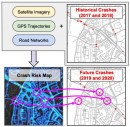Trained with historical crash data, road map inputs, satellite imagery and GPS location, a sophisticated AI model can now prepare high-resolution crash mapping that researchers say will lead to safer roads.
The connected matrix of concrete and asphalt and road-related advancements such as GPS map apps, cameras and driver assistance tech now alert drivers to potentially dangerous collisions, but data for safety measures has lagged behind.
MIT’s Computer Science and Artificial Intelligence Laboratory (CSAIL) and the Qatar Center for Artificial Intelligence have now developed a “deep learning model” capable of predicting traffic patterns with high-resolution “crash risk” maps.
The system uses data to predict the expected number of crashes over a period of time to help identify high-risk areas and even predict future crashes.
The dataset the researchers used came from occurrences that happened within an area of more than 7,500 square kilometers from Los Angeles, New York City, Chicago and Boston. Among those four cities, the data suggests that L.A. was the most unsafe and suffered the highest crash density. In order, the least safe areas for crashes behind Los Angeles were New York City, Chicago, and Boston.
Before now, risk maps could only collect data points over areas in the hundreds of meters. The new maps contain 5×5 meter grid cells to provide more granular detail.
Songtao He, a lead author on this paper, says that by capturing the underlying risk distribution that determines the probability of future crashes at all places, and without any historical data, researchers can plot safer routes. He says this kind of detail and mapping will let auto insurance companies provide “customized insurance” plans based on driving patterns.
The researchers say car accidents consume some 3 percent of the world’s total GDP and are currently the leading cause of death in children and young adults.
Scientists used crash locations and data from 2017 and 2018, and then tested the AI results against those occurrences to predict crashes in 2019 and 2020. The researchers say certain locations were identified as “high-risk” even though those areas showed no recorded crashes.
“Our model can generalize from one city to another by combining multiple clues from seemingly unrelated data sources. This is a step toward general AI, because our model can predict crash maps in uncharted territories. The model can be used to infer a useful crash map even in the absence of historical crash data, which could translate to positive use for city planning and policymaking by comparing imaginary scenarios,” says a lead scientist from Qatar Computing Research Institute (QCRI) Amin Sadeghi, another lead author of the paper.
He adds that if drivers can use the risk map to identify potentially high-risk road segments, they can use apps like Waze, Google Maps and Apple Maps to avoid those areas ahead of crashes.
MIT’s Computer Science and Artificial Intelligence Laboratory (CSAIL) and the Qatar Center for Artificial Intelligence have now developed a “deep learning model” capable of predicting traffic patterns with high-resolution “crash risk” maps.
The system uses data to predict the expected number of crashes over a period of time to help identify high-risk areas and even predict future crashes.
The dataset the researchers used came from occurrences that happened within an area of more than 7,500 square kilometers from Los Angeles, New York City, Chicago and Boston. Among those four cities, the data suggests that L.A. was the most unsafe and suffered the highest crash density. In order, the least safe areas for crashes behind Los Angeles were New York City, Chicago, and Boston.
Before now, risk maps could only collect data points over areas in the hundreds of meters. The new maps contain 5×5 meter grid cells to provide more granular detail.
Songtao He, a lead author on this paper, says that by capturing the underlying risk distribution that determines the probability of future crashes at all places, and without any historical data, researchers can plot safer routes. He says this kind of detail and mapping will let auto insurance companies provide “customized insurance” plans based on driving patterns.
The researchers say car accidents consume some 3 percent of the world’s total GDP and are currently the leading cause of death in children and young adults.
Scientists used crash locations and data from 2017 and 2018, and then tested the AI results against those occurrences to predict crashes in 2019 and 2020. The researchers say certain locations were identified as “high-risk” even though those areas showed no recorded crashes.
“Our model can generalize from one city to another by combining multiple clues from seemingly unrelated data sources. This is a step toward general AI, because our model can predict crash maps in uncharted territories. The model can be used to infer a useful crash map even in the absence of historical crash data, which could translate to positive use for city planning and policymaking by comparing imaginary scenarios,” says a lead scientist from Qatar Computing Research Institute (QCRI) Amin Sadeghi, another lead author of the paper.
He adds that if drivers can use the risk map to identify potentially high-risk road segments, they can use apps like Waze, Google Maps and Apple Maps to avoid those areas ahead of crashes.







